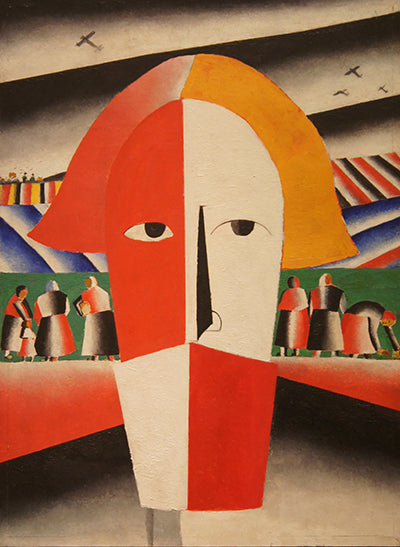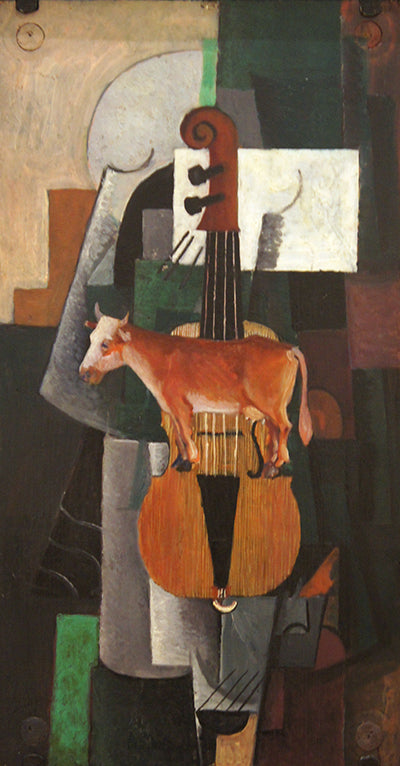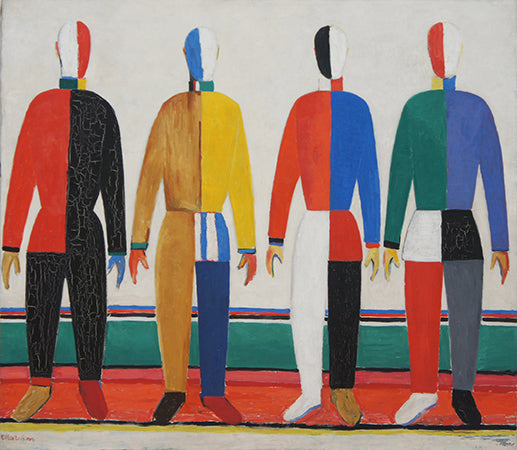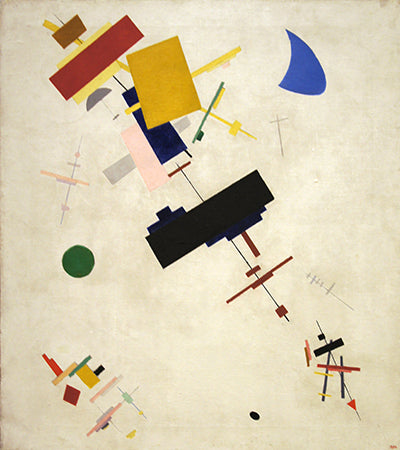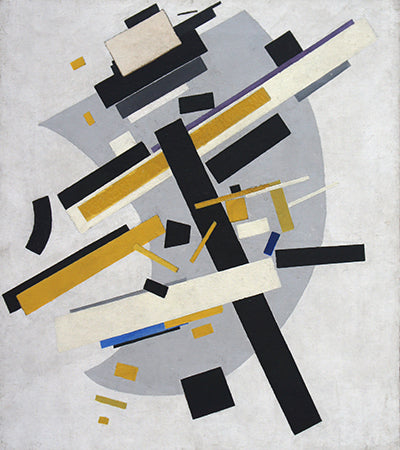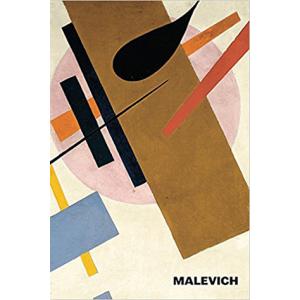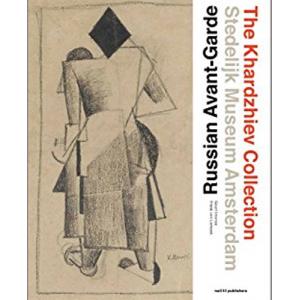Kazmir Malevich
by E.F. Kovtun

(Fig. 1) Malevich, "Black Square," 1913, oil canvas. Leningrad, State Russian Museum.
In recent years a rather extensive literature about Kazimir Malevich has accumulated, and it continues to grow. And the work itself has turned out to be much more varied than it appeared to scholars only a few years ago. In the short time between 1903 and 1913 Malevich went from impressionism to the varying forms of Russian Fauvism (Primitivism and further) to cubism and suprematism. But the objectless canvases – his "Black Square" (Fig. 1) – were not the last phase in Malevich's creative development. The present essay includes a discussion of the later, almost unknown works by Malevich, done beginning in the late 1920s. In these canvases Malevich returns to a figurative style, but one that has memories of suprematism. This last period is perhaps his greatest.
The decades that were passed in France in the renewal of art (beginning with impressionism) were consolidated in Russia into ten or fifteen years. Malevich's growth as an artist was similarly compressed. From the first, features inherent in the personality of the artist appeared in his work: a rigorous energy, a striving for a specific end, and finally, a genuine passion for painting. Malevich once said to a pupil about his youth, “I once worked as a draftsman, ... as soon as work ended, I would rush straight to a sketch, to my paints. You just grab them and rush to the sketches. And this feeling for painting can be extremely, unbelievably strong. A person could simply explode.”1

(Fig. 2) Malevich,"Cow and Violin" 1911, mixed media, Leningrad, State Russian Museum.
Beyond-the-Mind Realism
From the beginning of the 1910s, Malevich's work was a kind of proving ground in which painting tested and perfected new possibilities. Explorations were carried out in various directions. Malevich was attracted to cubism and futurism, but his principal achievement in these years was a cycle of pictures which he termed "alogism," or "Beyond-the-Mind Realism:" Cow and Violin, Aviator, Englishman in Moscow, Portrait of Ivan Kliun. These presented a new method of spatial organization in the picture, unknown in French Cubism. In alogism Malevich attempted to move beyond the boundaries of the common sense which establishes connections between superficial phenomena. Russian painting, especially Malevich's experiments, attempted to achieve a deeper knowledge of the world through intuition, to master intuition as a creative method. Similar aspirations may be discerned in the poetic work of V.V. Khlebnikov, AE. Kruchenykh, E.G. Guro, and others. That which was closed to the usual reason had to become clear in the intuition, whose working ought to be forced and come out of the unconscious. “The new creative intuitive reason, by replacing unconscious intuition,” M.V. Matiushin wrote, “will give to the artist all the strength of its knowledge.”2
Malevich's Cow and Violin and Futurism, of 1911 (Fig. 2) was the earliest manifesto of alogism. On the on reverse of this canvas Malevich wrote: “An alogical confrontation of the two forms a cow and a violin – as a moment of struggle with logic, with naturalness, with Philistine sense and prejudice. – K. Malevich.” The combination of cow and violin, absurd from the point of view of common sense, proclaimed a universal connection of phenomena in the world. Intuition reveals “remote links in the world,” which the usual logic sometimes perceives as absurd. To realize that any particular event is included in a universal system, to see and embody the invisible which is revealed to spiritual sight – this is the essence of post-cubist explorations in Russian painting. It is most keenly expressed in the works of Malevich. For him the transrational is not the irrational; it has its own but of a high order. In 1913 Malevich wrote to Matiushin: “We have come as far as the rejection of reason but we rejected reason so that another kind of reason could grow in us, which in comparison to what we have rejected, can be called beyond-reason, which also has law and construction and sense, and only by knowing this will we have work based on the law of the truly new, the beyond-reason.3 It was not by chance, therefore, that even as he withdrew even further from visual reality, Malevich persisted in using the word realism to define his styles: Cubo-Futurist Realism, Beyond-the-Mind Realism; even the suprematist manifesto bore the subtitle The New Realism in Painting.
A Beyond-the-Mind Realist picture entered into a new relationship with the surrounding world. It still had an up and down, but it lacked weight, as if its plastic structure were suspended in universal space. The absence of gravity as an organizing structural principle is especially keenly felt in Aviator, in which the figure seems to rise up or soar in its weightlessness.

El Lissitzky's poster for a post-revolutionary production of the opera. The macaronic caption reads: All is well that begins well and has not ended.
Victory Over the Sun
The idea for futurist performances arose after the joining, in March 1913, of the Union of Youth artists with Hylea, a literary group which included Vladimir Mayakovsky, Velimir Khlebnikov, Elena Guro, Alexei Kruchenykh, Vladimir and Nikolai Burliuk, and Benedikt Livshits. At Matiushin's summer house in Uusikirkko (Karelsky Isthmus), Finland, in the summer of 1913, the First All-Russian Congress of Futurists was held. Malevich and Kruchenykh attended. The Congress participants issued a manifesto, in which they announced the creation of a theater for Future-People and coming performances.5 Work on the opera Victory Over the Sun began right there at the summer house. The poets Khlebnikov and Kruchenykh,6 the composer Mikhail Matiushin, and the artist Malevich joined forces for the production of the opera; it played on 3 and 5 December 1913 at the Luna Park Theater in St. Petersburg.
Malevich's sketches for the costumes were cubist, but inclined towards object lessness. The drawings Futurist Strongman, Grave Digger, and A Certain Evil Intender,7 have colored planes and black squares and rectangles. Malevich's reorientation towards suprematism is felt even more clearly in the sketches for the curtain and backdrops; the suprematist square is the basis of their composition. A similar drawing was published on the cover of the publication Victory Over the Sun (December 1913). But the artist himself had still not recognized these important changes in his work. This is evident from his letters to Matiushin, who intended to publish a new edition of Victory Over the Sun in 1915. “I would be very grateful if you would include a drawing of mine for the curtain in the act where the victory took place.... That drawing will have great significance in painting. That which was done unconsciously, now bears extraordinary fruit.”8 Enclosing the drawing in a following letter, Malevich added: “The curtain depicts a black square, the embryo of all possibilities; in its development it acquires a terrible strength. It is the ancestor of the cube and the sphere; its disintegration brings an amazing standard in painting.”9 Here, in drawings for Victory Over the Sun, the final transition to suprematism was accomplished.

(Fig. 3) Malevich, "Dynamic Suprematism," 1916, oil on canvas. Moscow, State Tretyakov Gallery.
The "Last Futurist" Exhibition
The new direction in Russian painting, even after it appeared, remained without a name for quite sometime. Until the fall of 1915 no one but Malevich knew what was happening in his studio. Only in the middle of 1915, when at least thirty objectless paintings had been finished (Fig. 3), did Malevich give the name suprematism to his work. The Moscow artists during 1915 were preparing a final exhibition of cubo-futurism, but in it Malevich intended to exhibit and affirm his new style. Ivan Kliun and Mikhail Menkov exhibited with him, the first artists to adopt the suprematist idea. The other participants in the exhibition, however, objected to calling Malevich’s work Suprematism in the catalog. The artist had to acquiesce, but the brochure about suprematism which he had prepared was available at the opening of the exhibition. “In addition, the artist hung up a sign saying “Suprematism in Painting. K. Malevich.”
The Last Futurist Exhibition 0.10 (Zero-Ten) opened at N.E. Dobychina's Petrograd Art Bureau on Mar’s Field on 17 December 1915. No scholar has yet considered the odd numerical ending of the exhibition’s name. Apparently, it has been taken as the ordinary capriciousness of the Futurists. One contemporary critic commented that the name of the exhibition was “mathematically illiterate.” Actually, “0.10” – that is, “one-tenth” – does not correspond at all to the translation in the parentheses, “zero-ten.” Malevich’s letters, however, illuminate the problem. On 29 May 1915 he wrote, “We are undertaking the publication of a journal and are beginning to discuss how and what. In view of the fact that in it we intend to reduce everything to zero, we have decided to call it Zero. We ourselves will then go beyond zero.”11 The idea of reducing the forms of all objects to zero and progressing beyond zero into object lessness belonged to Malevich. In the brochure that was sold at the exhibition the artist announced his complete break with the forms of objects. He wrote: “I have turned myself into the null of forms and have gone out beyond 0-1.”12 The nine other participants in the exhibition also aspired to go beyond zero. This is the source of the zero-ten in the parentheses. A letter from Ivan Puni to Malevich from July 1915 collaborates this interpretation of the exhibition’s title: “We have to paint a lot now. The space is very large and if we, ten people,13 paint twenty-five pictures apiece, then it will be only just enough.”14

Kazimir Malevich, "Suprematism" (Supremus No. 58) 1916
Suprematism
At the beginning of the twentieth century, many major artists and poets – Malevich, Pavel Filonov, Khlebnikov, and others-recognized or guessed intuitively that a person is like a small universe, and that a work of art is an independent world which has its own, essentially spiritual essence. In the art of early twentieth-century artists of this autonomous world, which, of course, a genuine work of art has always been, acquired special features. It was organized like the universe, correlated with it, rather than with the earth and its particular laws; it joined the universe as an equal. Malevich’s suprematist canvases were like that. Their artistic structure, as distinct from that of the alogism period, did not correlate at all with the direction of earthly gravity, and so not only the impression of heaviness and weight disappeared, but also even the notion of up and down often was lost. Yet the object lessness of suprematism was not an absence of reality, it was an exit from the world of objects, a new aspect of reality, which nature, space, and reality had revealed to the artist. Malevich’s thought, his attitude as an artist towards the world, was imbued with the inspiration of space, just as the idea of time runs all-absorbing throughout the works of Khlebnikov. In the summer of 1917 Malevich even called himself the “president of space.”15 When he moved away from his former understanding of space in art, Malevich observed that in futurism and cubism, “space is cultivated almost exclusively; form because it is connected with object lessness does not convey even an inkling of the presence of universal space. This space is limited to the space which separates things from one another on the earth.”16 Space in Malevich’s suprematist pictures is a model and an analog of cosmic space. His painting is cramped on the earth, it yearns for the heavens. “My new painting,” he wrote, “does not belong exclusively to the earth.... And in fact, in man, in his consciousness, there is a striving towards space, a yearning to ‘take off from the earth.’”17 By assimilating the space of the picture to cosmic space, where the motion of planetary systems are unified, Malevich reduces the structural formation of pictorial space to relationships in which “weight is distributed into systems of weightlessness.”18
The theme of overcoming gravity and entering into the cosmos attracted many artists and poets early in the twentieth century. In Victory Over the Sun, one of the characters (the Reader) declares: “Free of the weight of universal gravity, we arrange our things fancifully, as if a rich kingdom were settling in.”19 Resistance to gravity is expressed by the spherical perspective in the works of Kuzma Petrov-Vodkin. “То overcome gravity is to sense planetariness with one’s whole organism,” wrote the artist.20 Кhlebnikov’s prognostic excerpt А Cliff from the Future (1921-1922) describes human life in Flying Cities, in а gravity-free environment: “People walk along a path, weightless, as if they were on an invisible bridge. On both sides a precipice drops off into an abyss; a terrestrial black boundary marks the road. Like а snake swimming through the sea, raising its head high, breast first through the air, swims а building – a reversed ‘L’. А flying building snake.” 21
In the development of his ideas about space in art, Malevich was the first Russian artist to arrive at analogous futurological conclusions. As early as 1913 he dreamt of the time “when large cities and the studios of modem artists will be supported by huge zeppelins.”22 In а brochure published in192023, he set down the possibility of interplanetary flight, orbiting earth satellites, and interplanetary satellite stations which would enable man to develop cosmic space. Some of these futurological projects are called “Planets for Earthlings” (Fig. 4). Possibly the philosophy of N.F. Fedorov, а thinker highly valued by the futurists, influenced these “cosmic enthusiasma.”24 But it is also important to emphasize something else: Malevich'’s plans and ideas were not the fruit of mere fantasy; they originated in the development of а certain concept of artistic space.
From the beginning suprematism exerted substantial influence on the work of many artists, at first in Russia and later abroad. Such major artists as Yuiun, Puni, Olga Rozanova, Nadezhda Udaltsova, Varvara Stepanova, Liubov Popova, and Alexander Rodchenko followed Malevich; suprematism became the banner of the time. From the beginning of the 1920s, it moved beyond the confines of easel painting. In 1915, at the Last Futurist Exhibition, Yuiun exhibited several volumetric suprematist constructions. They were essentially the first of the architections (arkhitektony), on which Malevich would begin to work in the 1920s. The architections substantiated Malevich’s pictorial space, the suprematist structures entered into real volume and became а prototype for contemporary architecture. Also, in the 1920s, Malevich and his pupils Nikolai Suetin and llya Chashnik worked а great deal in the production of porcelain, textiles, typography, and other forms of applied art.

Kazimir Malevich, "Suprematism" (Supremus No. 56) 1916
The Revolutionary Years – UNOVIS
In the years of the Revolution, which Malevich – like Mayakovsky – welcomed, the artist's creative work and his social activity reached the highest intensity. Не directed the art section of the Moscow Council, was а member of the board of IZO Narkompros (the Visual Art Section of the Commissariat of Education), was а major artist of the First State Free Studios in Moscow and was a professor at the transformed Academy of Arts. He published programmatic articles in the newspaper Art of the Commune and the journal Visual Art, and he participated in public debates. The announcement for one such debate reads: “First State Free Art Studios (formerly, the Stroganov School). Open studios. Meeting about ‘The New art and Soviet Power.’ Speakers: D.P. Shterenberg, V.V. Mayakovsky, K.S. Malevich, Rodchenko, and students.”25 At the same time Malevich did not cease his creative work. In the fall of 1918 Mayakovsky’s Mystery-Bouffe, with décor by Malevich, premiered in Petrograd. And in 1919, Malevich’s first one-man show opened in Moscow.
Malevich left Petrograd for Vitebsk in the fall of 1919. At the beginning of the Revolution this quiet, provincial city was transformed into а major artistic center. Vitebsk was unusually lucky then; the art school was organized by Marc Chagall, and besides himself, in the course of two or three years such major figures as Malevich, Puni, Mstislav Dobuzhinsky, Ksenia Boguslavskaya, Robert Falk, Vera Ermolaeva, and Alexander Kuprin taught there. With Malevich’s arrival at the Vitebsk school its artistic life acquired а special intensity. His advocacy of the new art fired the students, who were attracted by his unflagging energy, his belief in his ideas, his uncompromising courage in the search for new directions.

(Fig. 4) Malevich, "Suprematist Architectural Drawing," 1924, pencil. NewYork, The Museumof Modern Art
In January 1920 the group POSNOVIS (an acronym for Followers of the New Art) arose within the school; its exhibition opened on 6 February. Shortly afterwards, on 14 February, at a meeting at which Malevich spoke to the artists, the group UNOVIS (Affirmers of the New Art) was organized. The aim of UNOVIS was the complete renovation of the artistic world on the basis of suprematism and the transformation, through new forms, of the utilitarian aspects of life. Besides Vitebsk, UNOVIS groups were organized in Moscow, Petrograd, Smolensk, Samara, Saratov, Perm, Odessa, and other cities. The Vitebsk UNOVIS, headed by Malevich, had а nucleus which included Ermolaeva, El Lissitzky, Nina Kogan, Lazar Кhidekel, Chashnik, and Suetin. UNOVIS brought a special poignancy and effort to the artistic life of Vitebsk. The city experienced аkind of sudden explosion, felt especially keenly during the days of celebration of the Revolution when Vitebsk was hung with unusual decorations – incomprehensible to the inhabitants. "I went to Vitebsk after the October celebrations,” the artist Sophia Dymshits-Tolstaia recounts in her memoirs, “but the city still glittered with Malevich’s decor circles, squares, dots, lines of various colors, and Chagallian flying figures. I felt that I had landed in а city bewitched – but at the same time that it was all possiЬle and marvelous, and the people of Vitebsk for that period had turned into suprematists. In essence, the population probably thought it some new kind of raid, incomprehensible but interesting, which had to be lived through." 26 The Vitebsk UNOVIS showed an exceptional persistence in striving to transform through art even the colorless existence of the city, its everyday life. UNOVIS artists painted factory banners and decorated trolley cars, made designs for speakers’ platforms, drawings for textiles, and color plans for interiors. Malevich often remarked that Vitebsk was а most important landmark in his work. Here for the first time suprematism moved extensively into the various aspects of life. The time in Vitebsk was also unusually fruitful for Malevich’s theoretical studies. “In this work Vitebsk played а large role in my life.”27

GJNKhUK. Тhe Theory of the Additional Element
In 1922, Malevich left Vitebsk for Petrograd with а large group of his students and began work at Petrograd's State Institute of Artistic Culture (GJNKhUK). The idea for establishing a research center for the study of the new problems in art originated with а circle of artists who felt the significance of the processes that were taking place in Russian art especially keenly. Filonov defined the significance of this moment as the time of “transfer of the center of gravity in art to Russia.”28 New styles demanded а theoretical basis and the critical tradition was insufficient to provide it. As the breach between the public and the artist grew, the artists themselves felt compelled to take over the theoretical work. This was all the more important since, given the complex, universal, and prognostic structures and models that the new art embodied, they demanded а serious scientific analysis and foundation. According to information published in the catalog of The First Report-Exhibition of Glavnauka Narkompros (Main Scientific Branch of the Commissariat of Education) from Moscow in 1925, the State Institute for Artistic Culture was founded in 1919. However, it went through a certain incubation period after its founding before the idea of the Institute was fully functional. There is а list of documentary landmarks which led from the beginning in the Museum of Artistic Culture (MKhK) to the establishment of GJNKhUK.
On 5 December 1918 а meeting was held of the Organizational Commission of the Museum: Nathan Altman, А.Е. Karev, and А.Т. Matveev. On 11 February 1919 а museum conference opened in the Winter Palace; this conference affirmed the organization of the museum. It was assigned exhibition halls in the Miatlev Residence on St. Isaac’s Square. Altman was appointed to organize the Museum. On 3 April 1921 the Division of Painting, which showed works of the new art, was opened to visitors. Later, the divisions of drawings, icons, and crafts opened. The Museum of Artistic Culture thus became the first state museum of modem art. On 9 June 1923 at a museum conference in Petrograd Filonov introduced а proposal in the name of a “group of left artists” to transform the Museum of Artistic Culture into an “institute for research in modem art.”29 In the same year, on 15 August, Malevich was selected as director of the Museum and on 1 October research divisions of the Museum were opened. In October of 1924 the Museum was reorganized into the Institute of Artistic Culture with Malevich as director and Nikolai Punin, deputy director. In addition to them, Vladimir Tatlin, Pavel Mansurov, and Matiushin served on the Advisory Board. On17 March 1925 the Institute was affirmed by the Council of People's Commissars (Sovnarkom) as а state institution.
The Institute became а major center of theoretical research in art. Its divisions were headed by Malevich, Tatlin, Matiushin, Mansurov, and Punin.The research program of the Institute and all of its divisions derived from post-cubist concepts in Russian art, which differed considerably from the theoretical positions of the leading European schools. The Italian Futurists and the French Purists based their art (painting and architecture) on the form and likeness of the machine, the highest achievement of twentieth-century technical civilization. But the machine is something secondary, i.e. it is a product of civilization. The GINKhUK artists strove for an art in which the spatial structure would arise according to the principles of natural generation of form, that is, on а primary base. The mode of formation and construction in art must arise out of experience of nature. The research inspiration of GINKhUK may be defined as organics, as opposed to mechanics, to аmachine civilization. Tatlin, а Constructivist, rejecting the logic of the right angle usual for Constructivists, designed his Monument to the Third Internationai (1920) on the basis of an inclined structure and а spiral. The model of Tatlin’s Tower shown at the 1925 Paris Exposition was created in GINKhUK. Filonov's method of analytic art tried to make the picture grow and take on form in а way similar to the development of а natural organism. Even in 1912, in his unpublished article “Canon and Law,” Filonov spoke out against "Cubo-Futurism which has reached an impasse due to its mechanical and geometric bases."30 Matiushin, whose work was based upon very attentive study of the laws of nature, developed the concept of а widened viewing, and expressed most directly the problems of an organic art. His division in the Institute was called the Division of Organic Culture. Finally, Mansurov in his Experimental Division was also concerned with the problems of an organicist. He studied the influence of natural structures on the generation of form in art. The theoretical studies of the Institute on principles of formation anticipated to а certain extent the ideas of bionics which became current ten years later.
The most outstanding section of the Institute was the Formal-Тheoretical Division headed by Malevich. It housed researchers, graduate students, and trade workers. Many well-known Leningrad artists went through Malevich’s division: Suetin, Chashnik, Khidekel, Anna Leporskaya, KI. Rozhdestvensky, Yuri Vasnetsov, V.I. Kurdov, Vladimir Stergilov, and others. Two were created within the division: Color and Form, headed by Ermolaeva and Lev Yudin. Malevich’s collective began a thorough study of the five major systems of the new art: impressionism, cezannism, futurism, bubism, and suprematism. The results of this work served as the basis of the theory of the additional element in painting which Malevich developed. In addition to his talent for painting, Malevich always had the heart of а researcher who tried to understand the reasons that impelled new forms in the world and in art and the logic of their development. There were even periods (the early 1920s) when, carried away by his researches, he abandoned the brush for the pen. In suprematism, Malevich saw the next consecutive step in the development of а universal artistic culture, in spite of its apparent break with tradition. In May of 1916, he wrote to Alexander Benois in defense of suprematism: “And I am happy that the face of my square cannot merge either with an artist or а time. Isn’t that so? 1 have not listened to the fathers and I am not like them. I am a step.” And further on: “In art there is an obligation to fulfill its necessary forms. Apart from whether I like them or not. Art doesn't ask you whether you like it or not, just as no one inquired when the stars were set in the sky."31 From these words it is apparent that Malevich considered suprematism a stage of development in а universal art. The transmutation of artistic forms and structures, the artist believed, was not arbitrary, but rather had an intimal logic. The lawfulness detected in the past defines аvector toward the future. For Malevich, suprematism was а continuation of futurism and cubism: “I affirm: futurism, via an Academism of forms, moves towards dynamism in painting. cubism, via the annihilation of the thing, moves towards pure painting. And both efforts in essence aspire to suprematism of painting.”32 Malevich saw the interconnection of all five basic systems of the new art, he noticed the development of one artistic form or structure from another, but he had not yet discovered the reasons for and the mechanics of such changes.
It is difficult to say exactly when, on the basis of these thoughts, the concept of the additional element occurred to Malevich, but in Vitebsk – by his own account – he had already seen it. Here he had encountered young people obsessed with art but in whose work the most varied influences from the latest trends collided. “Before me was the opportunity to do various experiments to study the action of additional elements,” the artist remembered. “I began to adapt the Vitebsk Institute for this analysis, and it let me conduct my work full speed ahead. I divided the painters into several typical types which, so far as was possible, I grouped according to one or another additional element. I was determined to confirm in nature some of my theoretical conclusions about the action of additional elements.”33 With the establishment of GINKhUK, working out the theory of the additional element became the principal task of Malevich’s division. By 1925, the artist had written the first general text, An Introduction to the Theory of the Additional Element in Painting. An expanded version was published by the Bauhaus in1927.34
By an “additional element” Malevich understood а new structural formative principle which arises in the process of artistic development. Its introduction into а plastic system that is taking shape reorganizes that system. A structural analysis of аmultitude of works of the new art revealed such additional elements as Cezanne’s filamentous curve, the cubist sickle-line, and suprematism’s straight line. The additional elements are defined both by color and by form for each system. The introduction of the cubist sickle-shaped curve into а Cezannist structure, for example, can change the picture being painted into а cubist painting. Malevich’s theory of the additional element is an original experiment in the structural analysis of аwork of art; it revealed active elements, or signs, which defined the organism of а work in each style. The merit of this system of signs was its ablity clearly to explain the development of plastic form and establish a mechanism for the transformation of one form into another.

(Fig. 5) Malevich, "Sportsmen," с. 1928 - 32, oil оп canvas. Leningrad, State Russian Museum.
The Berlin Exhibition
Malevich had long-standing connections with German art. At the 1912 Munich exhibition organized by the Blue Rider Society, the artist had exhibited his Peasant Head in 1922 а large Russian exhibition arranged by IZO Narkompros opened in Berlin. Malevich showed five works at this exhibition, four suprematist canvases – among them White on White – and а futurist canvas from 1911 – Knife Grinder: Principle of Flashing. Also, during the Vitebsk period there had been meetings with German artists. On 20 November 1920, UNOVIS announced that “the transportation of UNOVIS materials to Germany had been sent” (Vitebsk Art Committee List). Unfortunately, it has not yet been possible to establish what that “transportation” was.
In 1927 Malevich made а trip to Berlin. He took with him, besides paintings and drawings of architections, explanatory theoretical charts showing the main tenets of the theory of the additional element, drawings, and а number of Matiushin’s charts. A major portion of this material is now kept in Amsterdam. On his way to Germany Malevich stopped in Warsaw, where he was known but where his work had never been seen. His exhibition opened in а section of the Polonia on 20 March. The Polish avant garde received Malevich warmly and the exhibition enjoyed great success. In а note from Warsaw Malevich wrote to Matiushin: “Dear Misha, I showed your charts together with mine; both created great interest. Oh, this relationship is remarkable. Glory pours down like rain.”35 Malevich delivered а lecture to the Polish artists on the theoretical research at GONKhUK on 25 March. Also, in March, he arrived in Berlin, where he would remain until 5 June. His one-man show formed part of the Grosse Berliner Kunstausstellung and was open from 7 Мау until 30 September. When he visited the exhibition, Anatoly Lunacharsky, the Soviet Commissar of Education, wrote: "In his genre Malevich has achieved remarkable results and great skill. I do not know whether such canvases will be painted after him, but I am sure that his style, which has already been applied as а decorative device-for example by the late Popova – may in this respect have а rich future.”36
The Bauhaus published Malevich’s book Die Gegenstandslose Welt in the same year, 1927, and his article “Suprematistische Architektur” appeared at about the same time.37 The last time while Malevich was alive that his painting was shown in Germany was at the Souyetmalerei exhibition in July 1930. In June of 1927, before the closing of his show, Malevich left Berlin. His work remained in Germany until after the war, when a major portion of it went to the Stedelijk Museum in Amsterdam.

Malevich's last Futurist Exhibition, 1915
After Suprematism
Malevich's last period of unusual creative activity began soon after his return from Berlin. In three or four years he made more than а hundred paintings and а large number of drawings. Some of this work, done between 1928 and 1932, was dated in the 1910s by the artist. How can one understand this disparity?
On 15 December 1920, as he was completing the brochure Suprematism. 34 Drawings, Malevich wrote: “I have established the definitive plans of the Suprematist system. Further development into architectural Suprematism I leave to young architects, in the wide sense of the word, for I see the epoch of the new architecture only in this. I myself have moved into an area of thought new to me and, as I can, I will set out what I see within the endless space of the human cranium.”38 And, indeed, paintings by Malevich from the period of Vitehsk UNOVIS and Leningrad GINKhUK are almost unknown. There were mainly old works at 1920s exhibitions. During these years Malevich created а large portion of his architections and worked intensely on his theoretical research. After quite а long painting silence, the artist, making up for omissions, attempted to realize some of the ideas he had had in the pre-Suprematist period. This explains, possibly, the artist’s notes on the reverse of certain late canvases: “Motif of 1903,” “Motif of 1910.”
Malevich’s one-man show of sixty works at the Tretiakov Gallery was held in 1929. А booklet containing an article by А. Fedorov-Davydov was published but not а catalog of the works.39 In а list of works exhibited which has been located, 40 several of the titles allow us to conclude that canvases from а late peasant cycle were actually shown. But these works were first recorded in the catalog for the exhibition Artists of the RSFSR after XV Years, which took place in the Russian Museum in 1932. Here were shown Color Composition, Three Figures, Sportsmen, Red House, and other late canvases (Figs. 5 and 6). We can judge that Malevich’s white faces appeared late from similar personages and decisions in the work of his followers. Only after the 1932 exhibition can they be seen in the work of Suetin, Ermolaeva, Leporskaya, Stergilov, and E.M. Krimmer.

Malevich, "Girls in a Field," 1928-29, oil on canvas
The artist’s late work elucidates his unique creative evolution. In the 1910s, he came to object lessness, to the Black Square, which was а rejection of painting in the usual sense. It would seem that there could be no return to the forms of objects in art. And in fact, in the twentieth century, it is hardly possible to find an artist who, like Malevich, would be able to return from object lessness to figurative painting. And not only to return, but to create splendid works. The last works of Malevich bear witness to a new flowering of his painting talent. He returned to figurativeness, but а figurativeness enriched by the achievements of suprematism which made itself felt in а previously unknown sensation of color and form clean, disciplined, and possessed of а pervasive brevity of line. In the faces and figures of the peasants who stand against backgrounds of colored fields there is an indirect, more moderate connection with Old Russian art than was present in the earlier peasant heads. The economy of plastic means and а kind of depictive reticence create a special graphic keenness to which Malevich consciously aspired. “The objectless and the half-formed works (like my peasants),” he said to Yudin, “have the most significance at this time. They act most keenly of all.” 41

(Fig. 6) Malevich, "Man with а Saw," ("On Vacation") 1927, oil on wood, Leningrad, State Russian Museum
Peasant images appear throughout Malevich's entire work. From 1908 to 1912 his paintings depicted work in the fields, and heads close in their fervor to those of Russian icons. Even in the early period of suprematism the artist tried to preserve аconnection with these images. Thus, for example, the well-known Red Square (similar to Black Square) was entitled in the 1915 0.10 catalog Painted Realism of a Peasant Woman in Two Dimensions. When he spoke about his youth, Malevich in his autobiography (published only in 1976) kept emphasizing his interest in the peasant way of life and in folk art. “The whole peasant life attracted me strongly.”42 The attraction was part of an anti-urbanism which the artist retained his whole life. In the vast Ukrainian fields where Malevich spent his youth, there were sown the impulses towards the color of his future canvases. “The peasants, large and small, worked on the [sugar] plantations, and I, the future artist, fell in love with the fields and with the ‘colorful’ workers who weeded and cut the beets. Throngs of girls in colorful clothing moved in rows across the whole field.”43 Malevich's second peasant cycle, done in 1928-1932, is significantly different from the first. The characteristics of everyday life are absent, there are no reapers or mowers, in all we see peasants standing against backgrounds of colored fields. They are always frontal; an air of solemnity, of monumentality and significance of origin is elicited by every work, although the paintings are completely without narrative action. It seems as if the Peasant (with а Black Face) and other personages of this cycle have entered organically into Malevich’s suprematist universe, which had, up until then, been unpopulated. Created after suprematism, the cycle preserves in a number of its works (Girls in а Field, Sportsmen) the cosmic feeling which Malevich’s objectless works convey so strongly.
These last pictures by Malevich have become one of the clearest and most original phenomena of twentieth-century painting. Malevich died more than forty years ago, but throughout the world interest in his work continues to grow and his aesthetic ideas have retained their value. The past decades have left no doubt that Malevich belongs among those few artists whose work alters the art of an entire epoch.
About the Author and Translator
E.F. Kovtun is curator of graphics at the State Russian Museum, Leningrad. The translated from the Russian was done by Charlotte Douglas, who has done extensive research on the works of Malevich and is currently writing about the works of Velimir Kblehnikov.
Notes
1. L.A. Yudin, Diary, entry for 27 October 1934. Archive of the artist's family, Leningrad.
2. М. Matiushin, On the Exhibition of 'The Last Futurists, Ocharrmannyi slrannik, Petrograd, 1916, 18.
3. K.S. Malevich, letter to М.У. Matiushin, June 1913. Manuscript Division of the State Tretiakov sky Gallery, f. 25, d.9,1.8.
4. The organizers of the society Union of Youth (1910-14) were М.У. Matiushin and E.G. Guro. Members included P.N.Filonov, О.У. Rozanova, I.S. Shkolnik, and У.1. Matvei. On 3 January 1913 the Muscovites K.S. Malevich, У.Е. Tatlin, and D.D. Burliuk were elected members. M.F. Larionov and N.S. Goncharova were con stant participants in the Union's exhibitions.
5. М. Matiushin, А. Кruchenykh, and К. Malevich, "The First All-Russian Congress of Singers of the Future (Poet-Futurists)," Za sem'dnei, 15 August 1913.
6. Y. Khlebnikov wrote the "Prologue" to the opera, which was played on stage by A. Khlebnikov.
7. These drawings along with seventeen more are in the Leningrad State Theatrical Museum.
8. Letter to M.Y. Matiushin from K.S. Malevich , 27 May 1915, in E.F. Kovtun, " Letters to Matiushin ," Ezhegodnilzrukopisnogo otdela Pushlzinslzogo @та na 1974 God, Leningrad, 1976, 185-86.
9. Letter to М.У. Matiushin, late May 1913, Ezhegodnilz, 180.
10. See the note by А. Rostislavov, Apollon, 1916, 37.
11. K.S. Malevich, letter to М.У. Matiushin , 29 Мау 1915, Ezhegodnilz, 186.
12. К. Malevich, From Cubism to Supremalism. The New Realism in Painting, Petrograd, 1916, 14.
13. These ten people were K.L. Boguslavskaia, I.Y. Кliun, K.S. Malevich, M.l. Menkov, У.Е. Pestel, L.S. Popova, 1.А. Puni, О.У. Rozanova, У.Е. Tatlin, N.A. Udaltsova. To them were added N.I. Altman, M.l. Yasileva, У. У. Kamensky, and А.М. Kirillova.
14. Manuscript Division of Pushkin House, f. 172, N.971.
15. K.S. Malevich, letter to М.У. Matiushin, Ezhegodnilz, 182.
16. K.S. Malevich, letter to М.У. Matiushin, Ezhegodnilz, 192.
17. Ibld
18. К. Malevich, God is not Cast Down, Yitebsk, 1922, 15.
19. Victory over the Sun, opera by А. Кruchenykh, music by М. Matiushin, St. Petersburg, 1913, 18.
20. K.S. Petrov-Yodkin, lecture theses, 1920s. Manuscript Division of the State Russian Museum, f. 105, ed. Khr. 15, 1.28.
21. Yelimir Кhlehnikov, Collected Works, IV, Leningrad, 1930, 296.
22. K.S. Malevich, letter to М.У. Matiushin, 9 Мау 1913. Manuscript Division of the State Tretiakov Gallery, f.25, d. 9, 1.2.
23. К. Malevich, Supremalism. 34 Drawings, Yitebsk, 1920.
24. Nikovai Fedorovich Fedorov (1828-1903), а librarian at the Rumiantsev Museum in Moscow and а mentor of К.Е.Tsiolkovsky.
25. Islzuss/vo. Vestnilz otdela IZO NКР, N. 8, 1919
26. S.I. Dymshits-Tols taia, Memoirs. Manuscript, Division of the State Russian Museum, f.100, ed. khr. 249, 1.67.
27. K.S. Malevich, "On the Theory of the Additional Element in Painting," paper given in GINКhUK, 16 June 1926. State Archive of the October Revolution and Socialist Construction (GAORSS), Leningrad, f.2555, ор. 1, d. 1018.
28. Р. Filonov, "Declaration of 'World Flowering',"Zblzn' islzusslva, 20, 1923.
29. Archive of the Filonov family, Leningrad.
30. Manuscript Division of Pushkin House, f. 656
31. K.S. Malevich, letter to А. Benois, Мау 1915. Manuscript Division of the State Russian Museum, f. 137, ed. khr. ll86.
32. К. Malevich, From Cubism to Suprematism. The New Realism in Painting, Petrograd, 1916, 9- 10.
33. К. Malevich, Introduction to the Theory of the Additional Element in Painting, 1925 (Printer's proofs). Private archive,Leningrad.
34. Kasimir Malevich, Die gegenstandsldse We/t, Munich, 1927.
35. K.S. Malevich, letter to М.У. Matiushin, 20 March. Manuscript Division of the State Tretiakov Gallery, f.25, d. 9, 1.24.
36. А. Lunacharsky, "Russian Artists in Berlin," Ogonelz, 30, 1927.
37. Wasmuths Monatsheftefur Вaulzunst, х, 1927.
38. K.S. Malevich, Suprematism. 34 Drawings, Yitebsk, 1920, 4.
39. Exhibition of the Works of К S. Malevich, State Tretiakov Gallery, Moscow, 1929.
40. Manuscript Division of the State Tretiakov Gallery, f.8.11, d. 286, 1.31.
41. L.A. Yudin, Diary entry for 21 September 1934 Archive of the artist's family, Leningrad.
42. K.S. Malevich, "Chapters from the Autoblography of an Artist,'' N. Кhardzhiev, К. Malevich, М. Matiushin, Кistoriirusslzogo avangarda, Stockholm, 1976, 107.
43. lbld., 103.
Kazimir Malevich
Author(s): E. F. Kovtun and Charlotte Douglas
Source: Art Journal, Vol. 41, No. 3, The Russian Avant-Garde (Autumn, 1981), pp. 234-241 Published by: CAA
Stable URL: https://www.jstor.org/stable/776564 Accessed: 20-05-2020 21:45 UTC


